
In recent years, contamination of the rivers and the soil by livestock wastewater
has been getting worse in the rural areas of Japan.
The wastewater is also causing groundwater pollution in the same areas
due to nitrate nitrogen and organic phosphorous compounds.
Based on the fundamental philosophy of ACT,
we have developed wastewater treatment systems to resolve the environmental issue.
We believe that by providing water purifiers at reasonable costs using our advanced technology,
we would make a valuable contribution to building a sustainable society.
Features of the wastewater purifiers
- They preserve agricultural or industrial fatty wastewater from decay and prevent a generation of malodor.
- They achieve high-efficiency water purification by microorganisms utilizing activated coal*1.
- They need no chemical substance such as ozone.
- The ACT system*2 emulsifies and disperses fat aggregations such as milk fat globule. It accelerates the purification process and enables miniaturization and simplification of the whole system.
- Smaller systems cost less than larger ones.
*2: Special filtering equipment to process aggregated fat
Schematic views of the wastewater purifiers

ACC: Activated coal SRT: Sedimentation and reservoir tank
Examples of wastewater purification
A vegetable processing factory
Substance: phosphorous
Result: phosphorous decreased from 6.14ppm to 0.01ppm in 24 hours
A plating factory
Subtance: rustproof oil, surfactant
Result: suspended solid decreased from 34ppm to 15ppm, n-Hex*3 from 18ppm to less than 5ppm
A body shop
Substance: mineral oil etc.
Result: BOD decreased from 69.1ppm to 12.8ppm, n-Hex from 42ppm to undetectable
A vegetable processing factory
Substance: phosphorous
Result: suspended solid decreased from 1,300ppm to 16ppm, BOD from 240 ppm to 120ppm, n-Hex from 30ppm to 3.5 ppm
Treatment of parlor wastewater
In the general remarks, treatment of wastewater containing much fat is difficult. Butterfat in parlor wastewater makes the treatment especially hard, and they had to build large and expensive treatment facilities or gave up the treatment before we developed new processing technology. Milk fat is hard to process because it forms small globules. The globules coagulate into large aggregates that tend to float on the water and cause various problems in the water treatment system.
For these ten years ACT has been holding shared researches with institutes such as AIST*4, and has utilized the activated coal and the ACT systems for our wastewater purifiers. Thus, ACT has developed the first activated sludge method for parlor wastewater treatment using no chemicals.
*4: National Institute of Advanced Industrial Science and TechnologyPurification test of water containing milk
We put the activated coal in water with 20vol% of milk, aerated the water with air for 23 hours, and eliminated 98.5% of fat(measured as n-Hex).Chemical composition of the milk used in the test
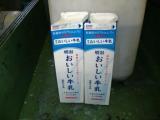
| nonfat solid | 8.5% |
| protein | 3.3% |
| carbohydrate | 4.8% |
| butterfat | 3.7% |
| BOD | 174,000mg/L |
Before and after the test
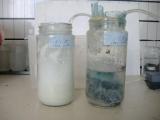
| before | after | removing efficiency | |
| n-Hex | 840mg/L | 13mg/L | 98.5% |
| BOD | 34,800mg/L | 6,260mg/L | 82.0% |
Pilot plant tests of the parlor wastewater treatment system at Obihiro
We made a pilot plant at Obihiro University of Agriculture and Veterinary Medicine and conducted verification tests of its purification performance. Some of the results are as follows:
We put water that contained 26.7% of waste milk in the system, and the BOD of the treated water decreased to 50mg/L. This value is significantly lower than the BOD regulation value in Japanese water effluent standards (120mg/L).


During the winter season, temperatures of the parlor wastewater decreased as low as 3.5 degrees centigrade, yet the COD of the treated water was less than 20mg/L throughout the season. Thus the effectiveness of the system in cold districts such as Hokkaido has been proved.
Examples of purification data in the coldest season
Sampling date: January 29, 2009| Items | raw water | treated water |
| BOC(mg/L) | 5,800 | 15 |
| COD(mg/L) | 3,100 | 35 |
| suspended solid(mg/L) | 2,200 | 11 |
| n-Hex(mg/L) | 1,600 | 1 |
| nitrogen(mg/L) | 270 | 3 |
| phosphorus(mg/L) | 41 | 2 |
Sampling date: March 16, 2010
| Items | raw water | treated water |
| BOC(mg/L) | 4,600 | 4.4 |
| COD(mg/L) | 3,100 | 14 |
| suspended solid(mg/L) | 2,800 | 4 |
| n-Hex(mg/L) | 240 | 1.4 |
| nitrogen(mg/L) | 340 | 9.8 |
| phosphorus(mg/L) | 80 | 22 |
Examples of our water purifiers are as follows:
| Capacity:16.5cbm/day Building area: 107.35sq.m |
 |
| Capacity: 3cbm/day Building area: 103.8sq.m |
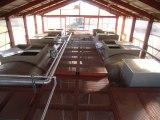 |
| Capacity: 5cbm/day Building area: 48.3sq.m |
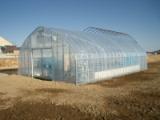 |
| Capacity: 25cbm/day Building area: 218.1sq.m |
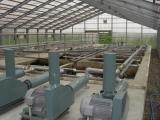 |
| Capacity: 6cbm/day Building area: 46.2sq.m |
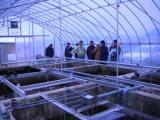 |
| Capacity: 6cbm/day Building area: 46.6sq.m |
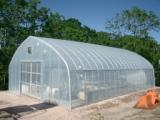 |
